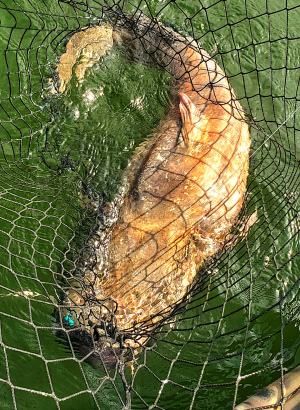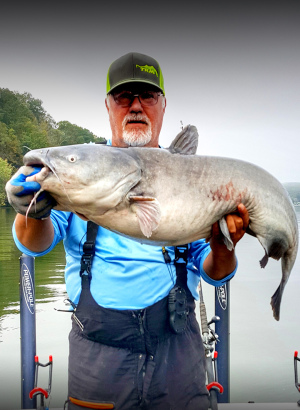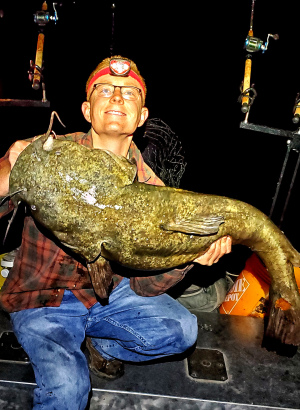The musky and flathead catfish are highly effective ambush predators in freshwater systems, known for their coloration, stealthy abilities, speed, and viscous attack. They consume almost any other fish in their domain, making traditional stinky baits ineffective. Catching trophy flathead catfish requires pinpointing singular fish and finding good points of structure, which can be achieved through topographical charts, bottom scanning, and water fishing.
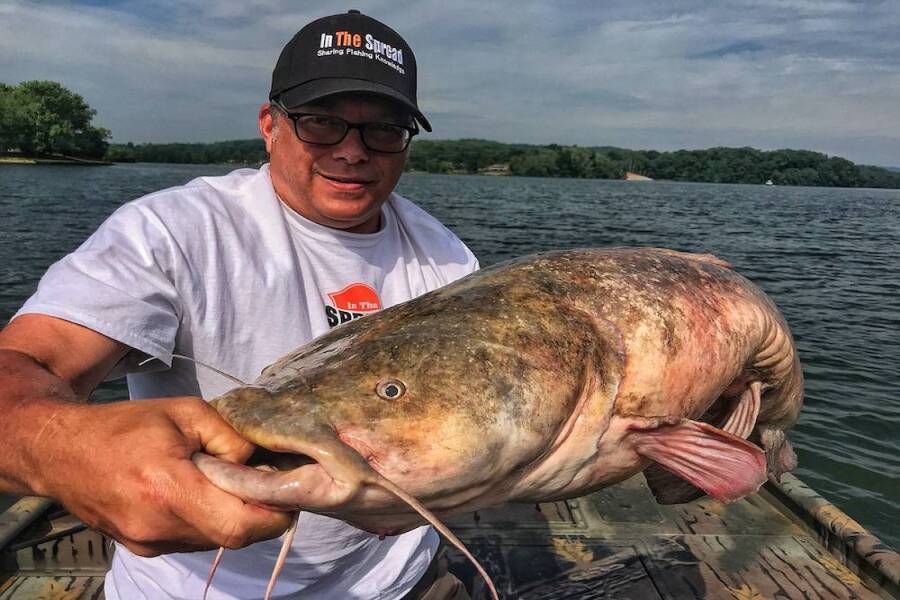
Flathead Catfishing - Catch More Cats
In the freshwater realm, there are but two apex predators that every other fish needs to worry about. The musky and the flathead catfish are without a doubt consummate ambush predators. Their coloration, absolute stealth like abilities, speed and viscousness of attack set these two killers apart from every other fish swimming around. While they live in the same water systems, they live and forage in dramatically different arenas, so they is very little chance of them meeting. The one hallmark that places them at the top of the food chain, is their ability to consume damn near any other fish in their domain.
Educate Yourself on Trophy Fishing Techniques
Flathead catfish are savage territorial serial killers with a discerning palate. This is a fish eating monster. Traditional stinky baits are just not effective with flatheads. Think about it. A large hulking solitary beast hidden from sight under a tree, behind a rock pile or in a depression in deep water exploding out of the darkness to snatch a hapless fish swimming past is the nightmare. Perch, sunfish, bream, bass or other catfish are on this assassins menu.
Cloaked in an olive tinted mud colored coat, flathead catfish lay perfectly still in the comfort of their camouflage. With a body built for speed and power, no prey is safe. A large gaping mouth with a protruding lower jaws administers the death grip. Nothing gets away. Combine all of the traits with formidable size and the flathead catfish is a force to be reckoned with.
Fishing for flathead catfish entails pinpointing singular fish. With maturity comes a burning desire to be alone in a dark place. There is a biological switch that goes off, pushing the fish to stake out a stretch of bottom and aggressively defend it against any and all intruders. Other flatheads are not even welcome. This is why catching trophy flathead catfish is so much more involved. With any given trophy flathead hole rarely holding more than one heavyweight adult, the challenge is finding myriad good points of structure. It is all about the structure. If you want to catch a number of big flathead catfish, you will need a lot of spots to drop baits on. You can easily find spots by reading topographical charts and bottom scanning along with spending a lot of time on the water fishing.
Habitat
There are a couple of core principles that determine where big flathead catfish will be found. Structure and current are paramount. Structure is the driver for any type of fishing, but it is perhaps even more so with the flatheads. They love cover. What type of structure or cover are we talking about? Fallen trees, stumps, submerged logs, rock ledges, debris piles, riprap and cavities or depressions on the bottom. From these vantage points, a systematic onslaught will ensue.
When it comes to the water system this species thrives in, look to deep runs in rivers, canals, lakes and reservoirs, where there is moving turbid water. You have to have good water flow. Current is critical. That is why most trophy sized flathead catfish are caught in large natural lakes, impoundments and big bottomland rivers. The more oxygenated the water, the more likely flatheads will be around. They will take flowing water to hardened sand, mud or gravel bottom any day. Hard bottom with good current is ideal. Where there is little water movement, there will be few if any fish.
Have you ever watched how a trout uses cover to move in and out of heavier current to feed. This is exactly what flatheads do. They do not necessarily want to battle the current. Rather, they will post up behind structure near strong current and rush out to snag a tasty morsel and then slip back to cover.
Feeding Behavior
Flatheads are aggressive predators and opportunistic, but very selective feeders. While young fish may feed on aquatic insect larvae, worms, crayfish, and small minnows, to get really big, you have to eat big. Even though adults may eat crayfish, it is live or dead fish. You cannot reach the size and weight flathead catfish achieve by eating insects and small invertebrates. Meat is required. It is not uncommon to find 2 lb largemouth bass in the stomachs of 30 to 40 inch flatheads.
As with most large freshwater predators, at some point the desire and need to consume meat takes over. Shad, carp, suckers, sunfish, largemouth bass and other catfish are all common food sources. Live fish seems to be the more desirable to the flathead that any other catfish, so keep that in mind when make bait choices. You don't have to fish with live bait to catch big fish, but it helps. The two biggest fish I have caught, both over 50 lbs., came on cut bait. However, that cut bait was fresh never frozen skipjack herring. The texture and scent were as close to live bait as you could possibly get.
Most of the feeding takes place at night and lots a giants are bagged after the sun sets. That doesn't mean big fish don't feed in the daytime. Remember, this is a opportunistic feeder and a nice presentation put in the right place will get devoured any time of day. The typical routine is for flathead catfish to seek shelter around or within a given set of structure during the daylight hours and then at night to leave their sanctuary and become more active, feeding in more shallow water.
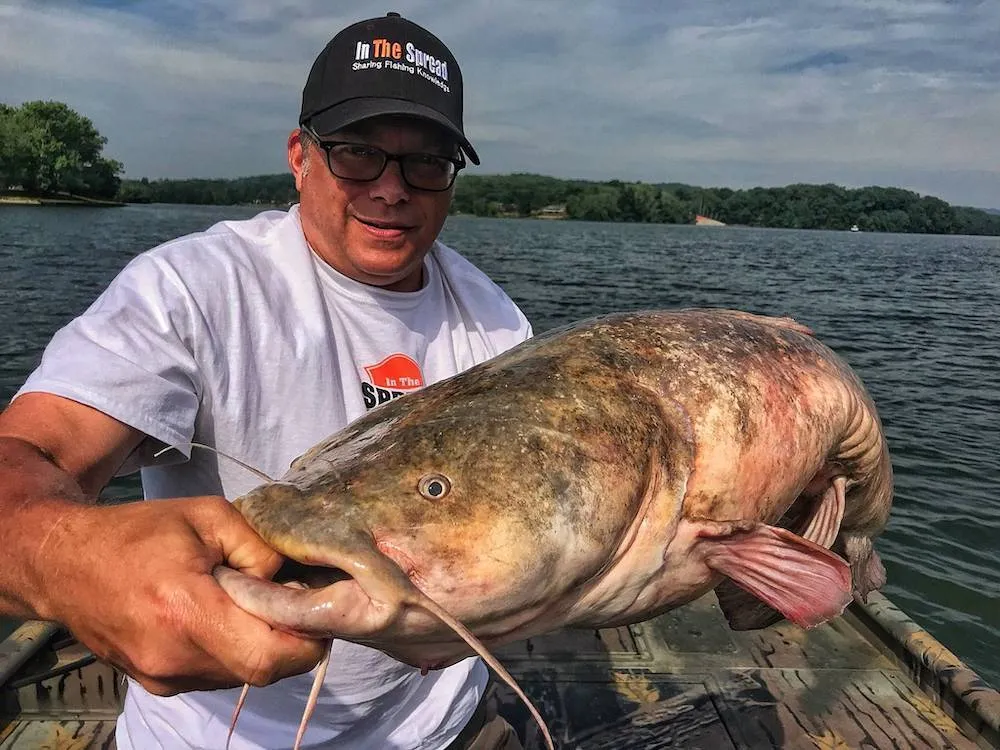
Predatory Behavior
Flathead catfish are like ghillie suited snipers. Prey never sees them or senses them until it is too late. This is a fish that hides around or within submerged logs, driftwood piles, toppled trees, snags, and riverbank or bottom cavities waiting to ambush unsuspecting fish. Flatheads aren’t not like wolves built for extended chases, preferring instead to dart out from hiding and devour unwary prey like a leopard. They will not roam very far from their home base, but when they do, it is at night or when rains create turbid, high-water conditions.
You are likely to catch big catfish below spillways during periods of heavy release. In the Fall time, when temperatures start to drop and energy requirements increase, hydroelectric dams start to discharge more water to generate electricity. Big flatheads are triggered by this and will move up into the tail waters to gorge on disoriented bait that is being sucked through with the spills. This Fall pattern coincides with the preparation for winter hibernation. You will see this as the water temperature drops. Biological tendencies dictate a heavier feeding pattern to fatten up, so the fish can survive until spring warms things again. You see a similar feeding pattern in the Spring time, as the fish emerge from their hibernation like state and the need to put on the feed bag drives a cycle of gorging.
If you are just getting started fishing for flathead catfish and are unsure where to begin you search for spots that hold nice fish, look for structure and rotating current areas in the bends of rivers or near cuts in shoreline revetment and riprap or bottom troughs along bluff banks with woody cover. You will find more success by fishing the upstream edges of structures.
A good idea would be to spend a day just driving around using your bottom machine to locate productive looking bottom structure. Mark areas on your machine that you would like to hit, so you can come back later and fish them. This way, you know precisely where to position your boat. When it comes to the fishing, do not motor around to much and certainly do not run over the top of your desired fishing area, if you can help it. Motor down upstream and drift into the spot you want to drop baits on. The idea is to get you anchor ready upstream, drop it and allow your line to come tight. Then use the rope to help position your boat upstream from the hole. This will help to not disturb the fish and also help you drift baits back to your target zone.
Flathead Catfish Fishing
If you’re seeking trophy flatheads, baits like stinkbaits, chicken livers, worms, crawfish, and other normal catfish baits rarely work. The big guys seldom eat invertebrates or rummage for dinner. The go to bait should be another fish or a super fresh dead bait. By super fresh, I mean never frozen and less that a day old bait that has been on ice.
Lively fish such as shad, herring, carp, bass, suckers, chubs, sunfish and small catfish make great baits. Goldfish and large shiners also are effective and readily available from bait dealers. Just be sure to check your local regulations for bait use and fish only with what's legal.
Flatheads can taste and smell certain compounds in the water in extremely minute quantities. This can be good because it helps them zero in on your bait. This is why live or freshly dead bait works best. Be mindful to avoid handling things such as gasoline, sunscreen, tobacco, and insect repellent before touching your baits.
When it comes to targeting big fish, you must assume an attitude of extreme patience. It is like buck buck deer hunting, You have to put in your stand time to get that big fish. The mistake most fishermen make is getting impatient. If the fish are not biting on a hole that you know holds good fish, more than likely they will not be biting a mile away. Stay on your spot, if it is proven and wait it out. The bite will turn on, at some point and sure as heck don't want to be running to another spot when it happens. Get set up, manage your baits, so they are always fresh and let them soak. Bit flathead catfish may need some time to find your presentation.


